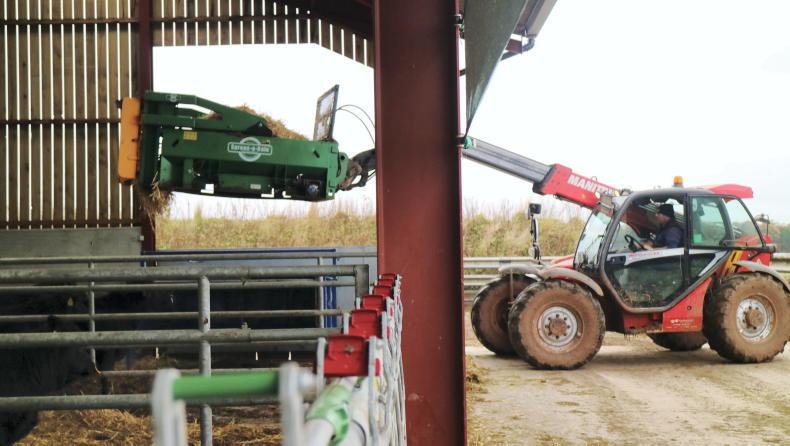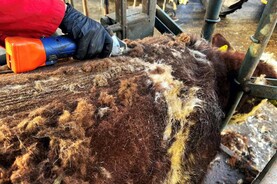Thanks to a poor harvest in England, straw demand south of the border is strong, driving prices in Scotland.
As it stands, some buyers are quoting prices of £90 per tonne ex farm with haulage to be added, and with the recent weather conditions leading to a longer winter up here, straw prices may not yet be finished rising.
Straw is being auctioned in Aberdeenshire at £12.50 per bale for inside straw 4 foot round bales.
Further south in Carlisle, mini hestons of inside wheat straw were selling for up to £118/t and round bales were selling for up to £34/bale.
The vast majority of Scottish suckler herds are wintered in straw-bedded courts. This means that the total spend on straw is greater on Scottish farms than in Ireland, despite the price per ton often being cheaper.

Andrew Gammie using a loader-mounted straw blower for his cattle courts.
The Scottish supply of straw comes from just under 500,000ha of cereal crops grown predominantly down the east coast.
Furthermore, significant volumes of straw are traded with England, heading both north and south depending on local demand.
There is also an increasing number of farmers who are collaborating with neighbours to exchange straw for muck as no cost.
This could become more popular in the coming years, as the Government continues to hint that future farm payments could be linked to soil health and carbon.
The SAC Farm Management Handbook suggests that an average spring-calving suckler cow system will require around 1.25t of bedding straw in a 180-day winter or around 7kg of straw per cow per day. Based on this, bedding is costing around 70 pence per cow per day just now.
Alternative bedding products are a quick answer
This is a situation that seems to be raising its head on a more regular basis for the beef farmer, so what can we do as we find ourselves once again looking at a high in the straw market?
Alternative bedding products are a quick answer, for a start. In 2018, many farmers moved to using dried woodchip, as there was a relative abundance of it at that time.
Since then, timber prices have changed and it is closer in cost to using straw. Chip also has the disadvantage of needing to compost for at least a year before spreading to break it down.

Recent days has seen hard frosts across much of Scotland. This has allowed the Biffens at Arnage farms near Ellon to muck out cattle courts.
One of the first suggestions that we have when looking at cattle housing is to install scraping passages at the feed fence.
Short term for this season, this could be as simple as mucking out down to the floor along the feed fence. However, longer term, installing rails and a step over will pay dividends.
Cubicles saving £37/cow
Scrape passages have been shown to reduce bedding requirements by up to a third.
On the straw price and usage details above, this would give a saving of £37 per cow. Looking longer term, this is a saving of £185 per cow over five years, giving quite a substantial budget to make shed alterations.
An even bigger change to make could be to alter the shed to cubicles or slats. Looking to the long-term, the rhetoric from government advisers is quite negative towards slats.
Having cows calve and go straight to grass gives a far better performance at a much lower cost than other systems
However, cubicles are a good option if the shed space and layout allow.
Moving to a cubicle system would mean that it would be more awkward to calve or bull inside. However, the key factor that we are pursuing at every stage here is to make the farm more profitable.
Having cows calve and go straight to grass gives a far better performance at a much lower cost than other systems.
Cubicles would mean a reduction in both feed and bedding costs in this case. It is also possible to get moveable cubicle systems, meaning that those who rely on their cattle accommodation for storage through the rest of the year can rest easy.
Taking the previous budget sums, the straw saving over 10 years would give a budget of £370 per cow to invest in a cubicle system.
Thanks to a poor harvest in England, straw demand south of the border is strong, driving prices in Scotland.
As it stands, some buyers are quoting prices of £90 per tonne ex farm with haulage to be added, and with the recent weather conditions leading to a longer winter up here, straw prices may not yet be finished rising.
Straw is being auctioned in Aberdeenshire at £12.50 per bale for inside straw 4 foot round bales.
Further south in Carlisle, mini hestons of inside wheat straw were selling for up to £118/t and round bales were selling for up to £34/bale.
The vast majority of Scottish suckler herds are wintered in straw-bedded courts. This means that the total spend on straw is greater on Scottish farms than in Ireland, despite the price per ton often being cheaper.

Andrew Gammie using a loader-mounted straw blower for his cattle courts.
The Scottish supply of straw comes from just under 500,000ha of cereal crops grown predominantly down the east coast.
Furthermore, significant volumes of straw are traded with England, heading both north and south depending on local demand.
There is also an increasing number of farmers who are collaborating with neighbours to exchange straw for muck as no cost.
This could become more popular in the coming years, as the Government continues to hint that future farm payments could be linked to soil health and carbon.
The SAC Farm Management Handbook suggests that an average spring-calving suckler cow system will require around 1.25t of bedding straw in a 180-day winter or around 7kg of straw per cow per day. Based on this, bedding is costing around 70 pence per cow per day just now.
Alternative bedding products are a quick answer
This is a situation that seems to be raising its head on a more regular basis for the beef farmer, so what can we do as we find ourselves once again looking at a high in the straw market?
Alternative bedding products are a quick answer, for a start. In 2018, many farmers moved to using dried woodchip, as there was a relative abundance of it at that time.
Since then, timber prices have changed and it is closer in cost to using straw. Chip also has the disadvantage of needing to compost for at least a year before spreading to break it down.

Recent days has seen hard frosts across much of Scotland. This has allowed the Biffens at Arnage farms near Ellon to muck out cattle courts.
One of the first suggestions that we have when looking at cattle housing is to install scraping passages at the feed fence.
Short term for this season, this could be as simple as mucking out down to the floor along the feed fence. However, longer term, installing rails and a step over will pay dividends.
Cubicles saving £37/cow
Scrape passages have been shown to reduce bedding requirements by up to a third.
On the straw price and usage details above, this would give a saving of £37 per cow. Looking longer term, this is a saving of £185 per cow over five years, giving quite a substantial budget to make shed alterations.
An even bigger change to make could be to alter the shed to cubicles or slats. Looking to the long-term, the rhetoric from government advisers is quite negative towards slats.
Having cows calve and go straight to grass gives a far better performance at a much lower cost than other systems
However, cubicles are a good option if the shed space and layout allow.
Moving to a cubicle system would mean that it would be more awkward to calve or bull inside. However, the key factor that we are pursuing at every stage here is to make the farm more profitable.
Having cows calve and go straight to grass gives a far better performance at a much lower cost than other systems.
Cubicles would mean a reduction in both feed and bedding costs in this case. It is also possible to get moveable cubicle systems, meaning that those who rely on their cattle accommodation for storage through the rest of the year can rest easy.
Taking the previous budget sums, the straw saving over 10 years would give a budget of £370 per cow to invest in a cubicle system.








 This is a subscriber-only article
This is a subscriber-only article










SHARING OPTIONS: